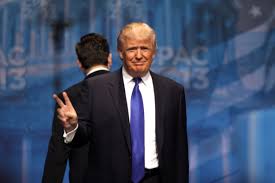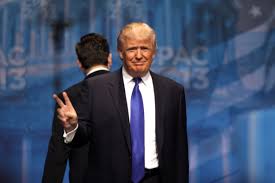
The yardstick for measuring the success of trade deals as identified by the Trump administration has been the trade deficits. But analysts say that it is a miscalculation.
For various U.S. trade deals including the North American Free Trade Agreement, or NAFTA, and the South Korea-U.S. free trade agreement, known as Korus, President Donald Trump has applied labels such as a "disaster" and "horrible".
The U.S. has trade deficits, meaning it imports more from some trade partners than it exports to those nations is what proves those deals are so horrible, Trump says.
"The United States has trade deficits with many, many countries, and we cannot allow that to continue," Trump said in June in a meeting with South Korean President Moon Jae-in.
But much as an indication of a pact's benefits is not offered by trade deficits, especially with a focus on manufactured goods, analysts have said. With the U.S. administration prioritizing goods, the measurement of trade disparities is often separated into goods and services categories as it currently stands.
Yet some large trade imbalances can't even be tied to any pacts despite the White House focus on deficits as evidence of deals' failures.
"Take China, for example, which is the country with which we have the largest trade deficit — over $300 billion. We don't even have a trade agreement with China," said Miriam Sapiro, the deputy U.S. trade representative during the Obama administration who also served in the Reagan, Bush and Clinton administrations.
Canada, which is a party to NAFTA along with Mexico, had a trade deficit with the U.S. even last year, Sapiro also noted.
"We didn't see Canada rushing to try to renegotiate NAFTA because it was worried," Sapiro, who currently heads the D.C. office of public relations firm Finsbury, said.
Eliminating trade deficits was unlikely to succeed, others said.
"The odds of perfectly balanced trade between any two countries are near zero," said Deborah Elms, executive director of the Asian Trade Centre. "I would argue that it's impossible to have perfectly balanced trade, especially when measured in trade in manufactured goods," she said.
without much consideration given to the service sector, where the U.S. often runs surpluses, the Trump administration has focused its attention largely on manufactured goods, Elms noted.
Additionally, larger reasons for the U.S. trade deficits, particularly the low savings rate is not tackled by trade agreements, she said.
"When it spends, it's sucking in imports," she said. "So the U.S. automatically runs a trade deficit."
But trying to achieve a more balanced trade could not be based on U.S. job creation even though the trade deficit could potentially weigh on it, others acknowledged.
"All else equal, a more favorable trade balance will raise demand and boost employment. But all else is not equal," J.W. Mason, an assistant professor of economics at John Jay College-CUNY and a Roosevelt Institute fellow, said in a note last year.
The U.S. can finance its trade deficits indefinitely, while other countries can't because the world essentially operates on a dollar standard, similar to the previous gold standard, he said.
"[P]olicies intended to improve the U.S. trade balance are likely to lead to lower growth elsewhere, imposing large costs on the rest of the world with little or no benefits here," he wrote.
(Source:www.cnbc.com)
For various U.S. trade deals including the North American Free Trade Agreement, or NAFTA, and the South Korea-U.S. free trade agreement, known as Korus, President Donald Trump has applied labels such as a "disaster" and "horrible".
The U.S. has trade deficits, meaning it imports more from some trade partners than it exports to those nations is what proves those deals are so horrible, Trump says.
"The United States has trade deficits with many, many countries, and we cannot allow that to continue," Trump said in June in a meeting with South Korean President Moon Jae-in.
But much as an indication of a pact's benefits is not offered by trade deficits, especially with a focus on manufactured goods, analysts have said. With the U.S. administration prioritizing goods, the measurement of trade disparities is often separated into goods and services categories as it currently stands.
Yet some large trade imbalances can't even be tied to any pacts despite the White House focus on deficits as evidence of deals' failures.
"Take China, for example, which is the country with which we have the largest trade deficit — over $300 billion. We don't even have a trade agreement with China," said Miriam Sapiro, the deputy U.S. trade representative during the Obama administration who also served in the Reagan, Bush and Clinton administrations.
Canada, which is a party to NAFTA along with Mexico, had a trade deficit with the U.S. even last year, Sapiro also noted.
"We didn't see Canada rushing to try to renegotiate NAFTA because it was worried," Sapiro, who currently heads the D.C. office of public relations firm Finsbury, said.
Eliminating trade deficits was unlikely to succeed, others said.
"The odds of perfectly balanced trade between any two countries are near zero," said Deborah Elms, executive director of the Asian Trade Centre. "I would argue that it's impossible to have perfectly balanced trade, especially when measured in trade in manufactured goods," she said.
without much consideration given to the service sector, where the U.S. often runs surpluses, the Trump administration has focused its attention largely on manufactured goods, Elms noted.
Additionally, larger reasons for the U.S. trade deficits, particularly the low savings rate is not tackled by trade agreements, she said.
"When it spends, it's sucking in imports," she said. "So the U.S. automatically runs a trade deficit."
But trying to achieve a more balanced trade could not be based on U.S. job creation even though the trade deficit could potentially weigh on it, others acknowledged.
"All else equal, a more favorable trade balance will raise demand and boost employment. But all else is not equal," J.W. Mason, an assistant professor of economics at John Jay College-CUNY and a Roosevelt Institute fellow, said in a note last year.
The U.S. can finance its trade deficits indefinitely, while other countries can't because the world essentially operates on a dollar standard, similar to the previous gold standard, he said.
"[P]olicies intended to improve the U.S. trade balance are likely to lead to lower growth elsewhere, imposing large costs on the rest of the world with little or no benefits here," he wrote.
(Source:www.cnbc.com)





